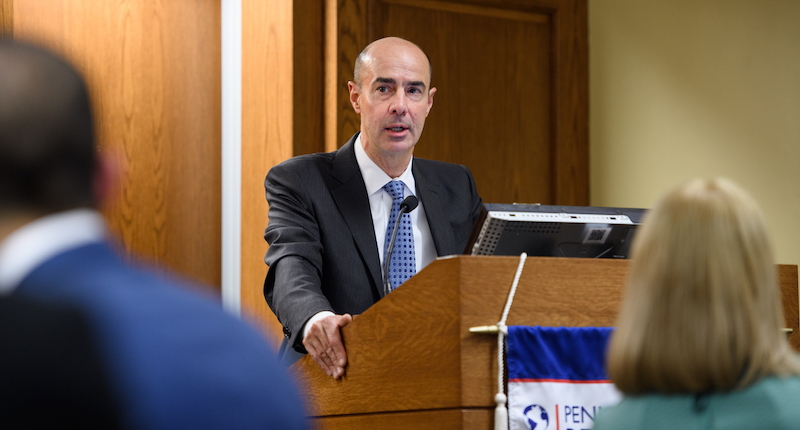
The Supreme Court’s decision in Michigan v. EPA illustrates that the public has a serious role to play in the rulemaking process.
In this lecture, I have been discussing the D.C. Circuit’s treatment of cost-benefit analysis in recent decisions involving financial regulatory agencies. But the most important recent cost-benefit decision is a 2015 ruling by the Supreme Court, Michigan v. EPA, a case that also illustrates something important about public participation in rulemakings.
Michigan v. EPA concerned a new rule of the U.S. Environmental Protection Agency that the agency had determined would impose about $10 billion in annual costs on power plants. EPA was required by statute to consider whether the rule it was adopting was “appropriate and necessary.” The agency declined to consider the rule’s costs as part of that inquiry.

The 2016-2017 Editorial Board of The Regulatory Review gathers before the PPR annual dinner.
The Supreme Court held that this was arbitrary and capricious. Justice Scalia explained in the opinion of the Court that “one would not say that it is even rational, never mind ‘appropriate,’ to impose billions of dollars in economic costs in return for few dollars in health or environmental benefits.” Rather, he said, “agencies have long treated cost as a centrally relevant factor in deciding when to regulate. Consideration of cost reflects the understanding that reasonable regulation ordinarily requires paying attention to the advantages and the disadvantages of agency decisions.” “‘Cost,’” he added, “includes more than the expense of complying with regulations; any disadvantage could be termed a cost.”
Justice Kagan, in dissent, disagreed that EPA had disregarded costs, but agreed with the five-justice majority that cost needed to be considered. “Cost,” she wrote, “is almost always a relevant—and usually, a highly important—factor in regulation.”
The upshot of Michigan v. EPA is that some form of cost-benefit analysis is appropriate in almost every rulemaking, except under statutes with an exclusive list of permitted considerations that does not include cost. And note that the Court’s conclusion did not turn simply on the statutory phrase, “appropriate and necessary.” The majority and dissent spoke more broadly. As Justice Scalia explained and Justice Kagan seemed to agree, the rulemaking process is about assessing pros and cons—reasons for doing something and reasons against it, or reasons for doing it some other way. If I can show an agency a less costly, less disruptive way of achieving its goals, it is likely arbitrary and capricious for the agency to take the more costly approach. Moreover, if I can show that a proposed agency action would have extremely costly effects that the agency has not yet considered, the agency has an obligation to consider those effects and explain why the rule it proposed nonetheless remains the best approach.
There is currently debate over whether Congress should enact more laws requiring cost-benefit analysis. (There is also debate about whether Congress should repeal existing laws that do require cost-benefit analysis.) But what Michigan v. EPA tells us is that cost-benefit analysis—that is, evaluating pros and cons—already is properly part of the rulemaking process.
Michigan v. EPA also reflects something larger about the rulemaking process that, for public participants in rulemakings, is empowering. There is a common perception that arbitrary-and-capricious review under the Administrative Procedure Act (APA) is impossibly deferential—almost insuperable—and that there is little that comments submitted for the rulemaking can do to shape the outcome. That is incorrect. Agencies have at least three central obligations in a rulemaking: (1) To consider significant comments that they receive, (2) to consider alternatives that are offered to their regulatory proposal, and (3) to alter the rule in light of these comments and alternatives, or—if they choose not to—to provide a sound reason for declining to do so.

2016-2017 Managing Editor Eric Schlabs listens to Eugene Scalia at the PPR annual dinner.
What this means for the public is that if you have a better idea than the government and present it cogently in a comment, the government had better take note: It needs to give that comment consideration and either adopt your idea or give a sensible explanation for not doing so.
So rather than seeing informal APA rulemaking as a sort of lawless, open plain where the agency to a large extent can go wherever it wants, another way to view it is as a forum where—in some respects—public commenters help shape the agency’s obligations: You, the public, supply the evidence; you supply the argument; and the agency has a duty to meet you on those terms. If you convincingly show there is a better way to achieve the agency’s goals, or that the proposed rule would have a seriously adverse effect that would not occur under another effective alternative approach, then in a sense you have helped set the terms of debate. The prospect of judicial review, and the APA’s requirement of reasoned decision-making, have empowered the public to force the agency to come to terms not only with its own proposal, but also with the public’s conception of alternative, superior ways to tackle the problem.
In this way, the public can inject substantive content into an agency’s decision-making that is not expressed on the face of the statute itself. Consider Michigan v. EPA as an example: The Clean Air Act did not explicitly require consideration of costs and benefits. But if commenters put in evidence of the proposed rule’s high costs, and of what they perceive as its limited benefits, the agency in most cases will have a statutory duty to consider those costs and benefits. The notice-and-comment process has forced the agency to consider substantive factors not required on the face of the statute.
This empowers the public, if it engages effectively in notice and comment. And let me be clear, for those who do not care for quantitative cost-benefit analysis, that the concept is not limited to cost-benefit analysis in a strict, quantitative sense; indeed it is not limited to cost-benefit analysis at all. The Court made clear in Michigan v. EPA that “cost” is broadly defined: “Consideration of cost . . . requires paying attention to the advantages and disadvantages of agency decisions.” Moreover, “‘cost’ includes more than the expense of complying with regulations; any disadvantage could be termed a cost.” Any significant relevant matter that you, as a commenter, inject into the rulemaking discussion, and that reflects an important advantage or disadvantage to a given regulatory approach, can become a matter that the government must take into account as it writes new federal rules.
This essay is the third of a three-part series, The Public’s Role in Administrative Law, drawing on Scalia’s keynote address at the 2017 Annual Penn Program on Regulation Lecture.




